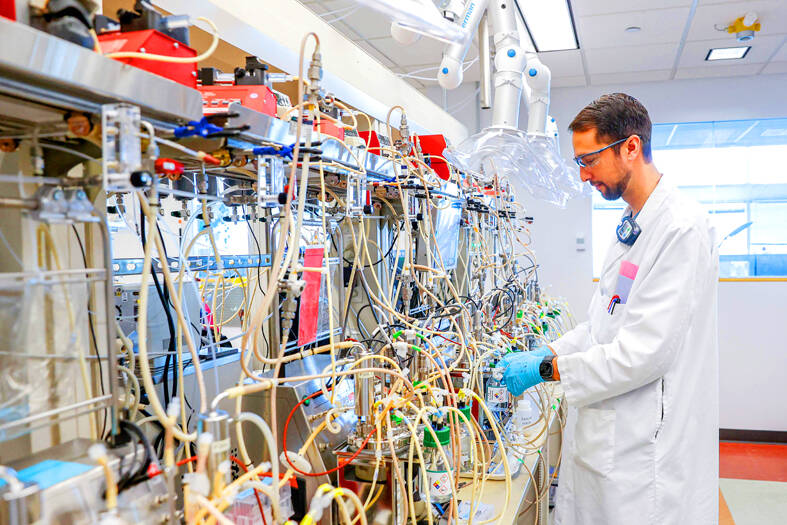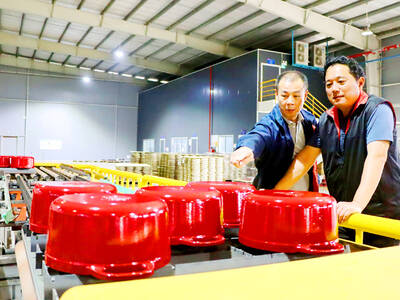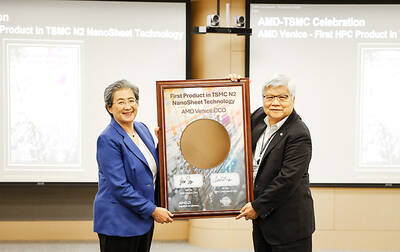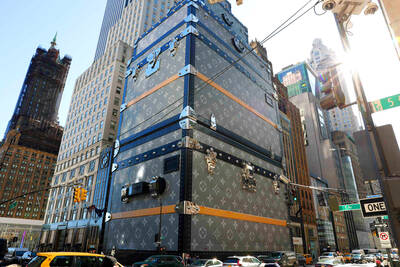At LanzaTech’s lab in the Chicago suburbs, a beige liquid bubbles away in dozens of glass vats. The concoction includes billions of hungry bacteria, specialized to feed on polluted air — the first step in a recycling system that converts greenhouse gases into usable products.
Due to licensing agreements, LanzaTech’s novel microorganisms are already being put to commercial use by three Chinese factories, converting waste emissions into ethanol.
That ethanol is then used as a chemical building block for consumer items such as plastic bottles, athletic wear and even dresses, via tie-ins with major brands such as Zara and L’Oreal.

Photo: AFP
“I wouldn’t have thought that 14 years later, we would have a cocktail dress on the market that’s made out of steel emissions,” said microbiologist Michael Kopke, who joined LanzaTech a year after its founding.
To date, LanzaTech has kept 200,000 tonnes of carbon dioxide out of the atmosphere, while producing 190 million liters of ethanol, the company said.
That is a small drop in the bucket when it comes to the actual quantities needed to combat climate change, Kopke said.
However, having spent 15 years developing the methodology and proving its large-scale feasibility, the company is now seeking to ramp up its ambitions and multiply the number of participating factories.
“We really want to get to a point where we only use above-ground carbon, and keep that in circulation,” Kopke said — in other words, avoid extracting new oil and gas.
LanzaTech, which employs about 200 people, compares its carbon recycling technology to a brewery — but instead of taking sugar and yeast to make beer, it uses carbon pollution and bacteria to make ethanol.
The bacterium used in its process was identified decades ago in rabbit droppings.
The company placed it in industrial conditions to optimize it in those settings, “almost like an athlete that we trained,” Kopke said.
Bacteria are sent out in the form of a freeze-dried powder to corporate clients in China, which have giant versions of the vats back in Chicago, several meters high.
The corporate clients that built these facilities then reap the rewards of the sale of ethanol — as well as the positive PR from offsetting pollution from their main businesses.
The clients in China are a steel plant and two ferroalloy plants. Six other sites are under construction, including one in Belgium for an ArcelorMittal SA plant, and in India with IndianOil Corp.
Because the bacteria can ingest carbon monoxide, carbon dioxide and hydrogen, the process is extremely flexible, LanzaTech vice president of science Zara Summers said.
“We can take garbage, we can take biomass, we can take off gas from an industrial plant,” said Summers, who spent 10 years working for ExxonMobil Corp.
Products already on the shelves include a line of dresses at Zara. Sold at about US$90, they are made of polyester, 20 percent of which comes from captured gas.
“In the future, I think the vision is there is no such thing as waste, because carbon can be reused again,” Summers said.
LanzaTech has also founded a separate company, LanzaJet, to use the ethanol to create sustainable aviation fuel (SAF).
Increasing global SAF production is a huge challenge for the fuel-heavy aviation sector, which is seeking to green itself.
LanzaJet is aiming to achieve 1 billion gallons of SAF production in the US per year by 2030.
Unlike bioethanol produced from wheat, beets or corn, fuel created from greenhouse gas emissions does not require the use of agricultural land.
For LanzaTech, the next challenge is to commercialize bacteria that would produce chemicals other than ethanol.
In particular, they have their sights set on directly producing ethylene, “one of the most widely used chemicals in the world,” Kopke said — thus saving energy associated with having to first convert ethanol into ethylene.

UNCERTAINTY: Innolux activated a stringent supply chain management mechanism, as it did during the COVID-19 pandemic, to ensure optimal inventory levels for customers Flat-panel display makers AUO Corp (友達) and Innolux Corp (群創) yesterday said that about 12 to 20 percent of their display business is at risk of potential US tariffs and that they would relocate production or shipment destinations to mitigate the levies’ effects. US tariffs would have a direct impact of US$200 million on AUO’s revenue, company chairman Paul Peng (彭雙浪) told reporters on the sidelines of the Touch Taiwan trade show in Taipei yesterday. That would make up about 12 percent of the company’s overall revenue. To cope with the tariff uncertainty, AUO plans to allocate its production to manufacturing facilities in

TAKING STOCK: A Taiwanese cookware firm in Vietnam urged customers to assess inventory or place orders early so shipments can reach the US while tariffs are paused Taiwanese businesses in Vietnam are exploring alternatives after the White House imposed a 46 percent import duty on Vietnamese goods, following US President Donald Trump’s announcement of “reciprocal” tariffs on the US’ trading partners. Lo Shih-liang (羅世良), chairman of Brico Industry Co (裕茂工業), a Taiwanese company that manufactures cast iron cookware and stove components in Vietnam, said that more than 40 percent of his business was tied to the US market, describing the constant US policy shifts as an emotional roller coaster. “I work during the day and stay up all night watching the news. I’ve been following US news until 3am

COLLABORATION: Given Taiwan’s key position in global supply chains, the US firm is discussing strategies with local partners and clients to deal with global uncertainties Advanced Micro Devices Inc (AMD) yesterday said it is meeting with local ecosystem partners, including Taiwan Semiconductor Manufacturing Co (TSMC, 台積電), to discuss strategies, including long-term manufacturing, to navigate uncertainties such as US tariffs, as Taiwan occupies an important position in global supply chains. AMD chief executive officer Lisa Su (蘇姿丰) told reporters that Taiwan is an important part of the chip designer’s ecosystem and she is discussing with partners and customers in Taiwan to forge strong collaborations on different areas during this critical period. AMD has just become the first artificial-intelligence (AI) server chip customer of TSMC to utilize its advanced

Six years ago, LVMH’s billionaire CEO Bernard Arnault and US President Donald Trump cut the blue ribbon on a factory in rural Texas that would make designer handbags for Louis Vuitton, one of the world’s best-known luxury brands. However, since the high-profile opening, the factory has faced a host of problems limiting production, 11 former Louis Vuitton employees said. The site has consistently ranked among the worst-performing for Louis Vuitton globally, “significantly” underperforming other facilities, said three former Louis Vuitton workers and a senior industry source, who cited internal rankings shared with staff. The plant’s problems — which have not